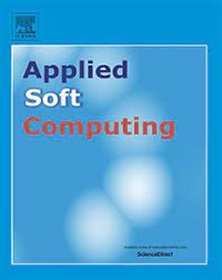Grey prediction evolution algorithm with a dominator guidance strategy for solving multi-level image thresholding
IF 7.2
1区 计算机科学
Q1 COMPUTER SCIENCE, ARTIFICIAL INTELLIGENCE
引用次数: 0
Abstract
Multi-level thresholding (MLT) stands as a pivotal method for extracting target information from images. Meta-heuristic algorithms provide an efficient way to implement MLT and retains more research space for accuracy optimization of high-dimensional multi-level thresholding (HDMLT) of images than they do for low-dimensional multi-level thresholding (LDMIT). In order to improve the algorithmic accuracy in solving the high-dimensional problems, a grey prediction evolution algorithm with a dominator guidance strategy (GPEdg) is proposed in this paper. GPEdg employs Otsu’s method as its objective function to find the best threshold configuration. The novel operator in the algorithm, i.e., a dominator guidance (dg) strategy, uses a linear combination of three difference vectors to guide the top 50% individuals of populations to learn from the top 20% of them. An efficient balance of search abilities suitable for solving HDMLT problems is expected to be achieved by injecting the local search capability of the dg strategy into GPE’s powerful global search capability. Furthermore, a thresholding morphological profile based method (TMP) leverages the thresholding results generated by GPEdg to train a support vector machine (SVM) for hyperspectral image classification. Numerical experiments are conducted for the newly proposed algorithm and five state-of-the-art algorithms on three image datasets to compare the performance in six metrics, i.e., peak signal-to-noise ratio, structural similarity index, features similarity index, objective function value, stability and time consumption. Overall accuracy and average accuracy are tested on two commonly used hyperspectral image data. The results show that GPEdg exhibits outstanding thresholding performance while TMP enhances the classification accuracy of these images. If this paper is accepted, Matlab_codes associated with this paper will be uploaded to https://github.com/Zhongbo-Hu/Prediction-Evolutionary-Algorithm-HOMEPAGE
求助全文
约1分钟内获得全文
求助全文
来源期刊

Applied Soft Computing
工程技术-计算机:跨学科应用
CiteScore
15.80
自引率
6.90%
发文量
874
审稿时长
10.9 months
期刊介绍:
Applied Soft Computing is an international journal promoting an integrated view of soft computing to solve real life problems.The focus is to publish the highest quality research in application and convergence of the areas of Fuzzy Logic, Neural Networks, Evolutionary Computing, Rough Sets and other similar techniques to address real world complexities.
Applied Soft Computing is a rolling publication: articles are published as soon as the editor-in-chief has accepted them. Therefore, the web site will continuously be updated with new articles and the publication time will be short.
 求助内容:
求助内容: 应助结果提醒方式:
应助结果提醒方式:


